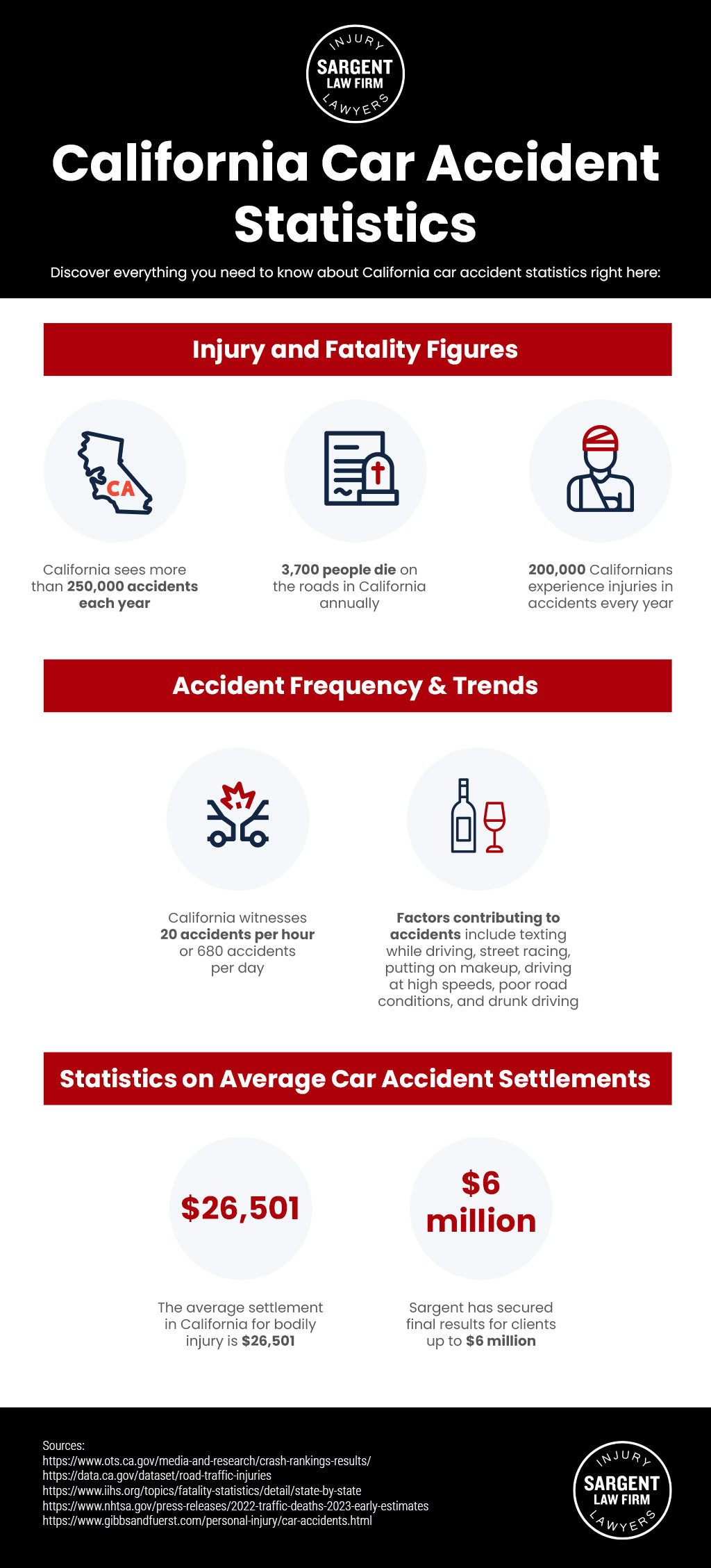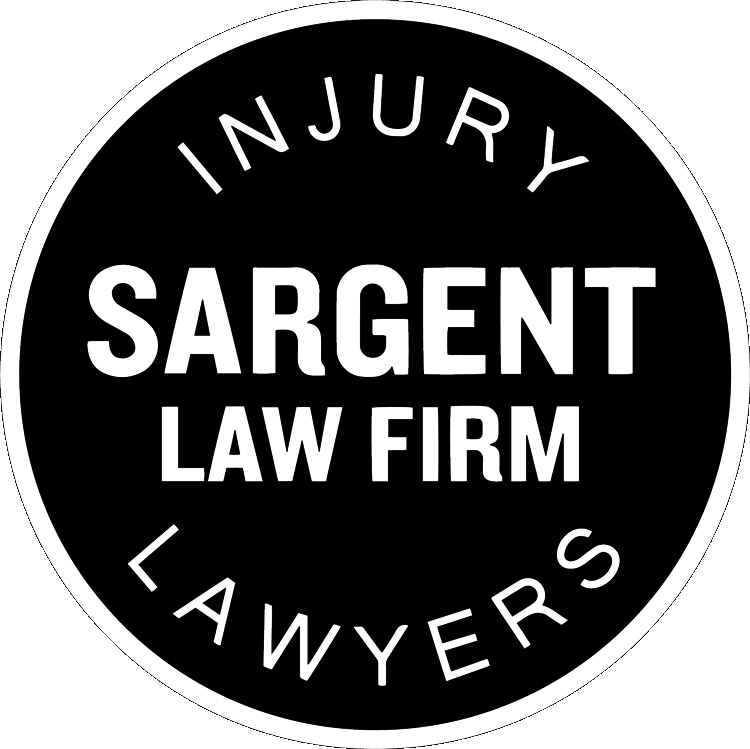You may feel like there’s nothing you can do after a car accident, but if your injuries and financial losses are the result of someone else’s negligence, you may be able to recover compensation for your damages.
A car accident attorney in California from Sargent Law Firm Injury Lawyers has the experience necessary to handle your case on your behalf. You can focus your time and energy on healing from your injuries while our personal injury attorney manages the legal process. Connect with us at (844) SARGENT to get started with your free consultation.
Our California Car Accident Lawyers Help You Recover Compensation
There are two primary types of damages you can recover after a car accident. Economic damages have a monetary value that evidence such as medical documentation, receipts, and pay stubs can validate. These damages typically include:
- Household services
- Lost income
- Home modifications
- Property damage
- Medical bills
- Childcare
Non-economic damages are more challenging to calculate a monetary value for but typically include:
- Pain and suffering
- Emotional distress
- Mental anguish
- Disability
- Disfigurement
- Lost quality of life
You may also be able to recover wrongful death damages to cover funeral costs, medical bills, and lost income if you lost someone you love in a car accident. If this is the case, we offer you and your family our thoughts and our sincerest condolences.
How Our Car Accident Attorneys in California Can Benefit Your Case
Car accident cases can quickly become complex. Your case may feel more difficult to handle due to the number of drivers, whether any laws were broken, and the severity of your injuries.
Handling a personal injury case on your own can be intimidating and frustrating if you lack knowledge of the legal process and the insurance claims system. It can be burdensome, especially if you are busy trying to take care of your family and heal from your injuries at the same time.
A car accident lawyer from our firm can evaluate and handle your case in California on your behalf. If you hire our firm to take your case, we will:
- Investigate the accident
- Gather evidence
- Determine liability
- Calculate the value of your case
- Negotiate a settlement
- Communicate with you
- Provide frequent updates
- Complete all paperwork
- Protect your rights
- File a lawsuit
We will walk you through the complex legal process as your case progresses, so you always understand what is going on. Your case could take weeks, months, or longer to resolve, but we will be there every step of the way.

It’s free to speak with us and learn the value of your case today.
Call Us Now
Our Car Accident Lawyers Work on a Contingency-Fee Basis
Worrying about the cost of hiring a lawyer from our firm is unnecessary because we work on a contingency-fee basis. This means you only pay us if we win your case and you recover compensation.
There are zero upfront costs to hire us, and we explain how payment works in detail so there won’t be any surprises. We also offer free consultations so we can answer your questions and evaluate your case.
You Have a Short Time to File a California Car Accident Lawsuit
You should take time to consider your legal options after a car accident. Consulting with a California car accident lawyer can help. However, be aware that you only generally have two years to file a personal injury lawsuit in California, according to CCP § 335.1.
If you do not file a lawsuit by the deadline in your case, the court could dismiss it, and you likely won’t be able to recover compensation for damages through the legal process. We will work to meet all deadlines in your case, including the statute of limitations.

Build a Car Accident Claim That Proves You Deserve Damages for Your Injuries
In most cases, the driving errors of one or more individuals are to blame for a car crash. Errors may be committed because the individual is not devoting enough care and attention to what they are doing.
In other cases, the individual who causes the accident may be aware of what they are doing and the risk of a serious crash that the behavior creates, but they choose to engage in the behavior anyway. This is often referred to as acting “recklessly,” as opposed to “carelessly.”
Our California car accident attorneys can help you prove the defendant caused your accident. Some common causes of auto accidents include:
Intoxication
Most Californians are familiar with the 0.08 alcohol limit set by statute. However, a person can be impaired by alcohol long before their blood or breath alcohol concentration reaches 0.08. Drugs can also impair an individual’s ability to drive safely, even if the drug is prescribed to the individual or can be legally purchased over the counter.
The impairing effects of some drugs can be magnified if alcohol is consumed with the drug(s). Driving while impaired not only significantly increases the likelihood that the impaired driver will be involved in a fatal or injury car crash, but it can also be considered careless and/or reckless behavior. This may mean the impaired driver has civil liability for any injuries and/or deaths they cause.
Distractions
Distracted driving is quickly becoming a common cause of car accidents. Texting while driving – taking one’s eyes off of the road to read or respond to a text message – is an especially dangerous form of distracted driving.
Some other actions and behaviors can also be considered distracted driving because they take the driver’s full attention off the task of driving and the road in front of them. Being distracted by landmarks or scenery, carrying on a conversation with passengers, attempting to adjust the car’s radio system, or dealing with an upset child can all divert the driver’s attention from the road – and can all be considered careless, negligent behavior.
Road Hazards
A large tree branch, a truck tire, potholes, or other similar debris can make driving safely an impossibility, requiring quick thinking and decisive action from drivers for collisions to be avoided. An improperly designed intersection or other roadway feature can also increase the risk of an accident. The design and maintenance of most highways and roads fall under the jurisdiction of at least one public agency.
These agencies have a responsibility for designing roadways that are reasonably safe for motorists and for maintaining these roads in a reasonably safe condition.
Steps to Take Following a Car Accident to Protect Your Claim
What you do in the moments after a car accident can have a profound impact on your ability to recover compensation for your injuries if it is determined that your car crash was caused by another’s negligence. Although the first few minutes and hours after a car crash can be extremely stressful and disorienting, you should try to:
Put Your Safety First
Your first concern should be getting yourself and your loved ones to safety. If the car can be safely driven, consider moving it to the side of the road out of the way of traffic. If you are uncertain about the condition of the car, or if you are injured, leave the car where it is and focus on your injuries. Be aware of leaking fuel and other combustible fluids – if you notice a fuel leak, get yourself and others to a safe distance as soon as possible.
If you suspect that you or a loved one has sustained a serious head, neck, or spine injury, do not move them unless it is necessary to save the person’s life. Moving a person with a head, neck, or spine injury without properly stabilizing the person can result in even more serious damage.
Summon Law Enforcement
You should report an accident to the police if there is damage to property and/or personal injury to someone. If you suspect that someone has an injury – or if you have concerns about being hurt yourself, you should request that emergency medical personnel respond to your crash as well.
Even if you do not feel hurt, you should seek medical attention as soon as possible after the accident. Some serious injuries may not manifest any outward symptoms for hours or even days after the accident. Delaying medical evaluation and treatment until symptoms first begin to appear can result in more severe damage and longer treatment periods.
Avoid Admitting Fault
Admitting fault for causing the accident may make it more difficult for you to recover financial compensation for your injuries. For this reason, refrain from making any statements such as “I’m sorry,” or “it’s my fault” to anyone, including the other driver.
If law enforcement asks you to provide details about the accident, only provide those details that you are certain are true and correct. Do not “guess” at your speed, whether your light was red, or whether you applied your brakes before the accident. Insurance companies and other drivers can rely on these statements and reduce or deny your claim for compensation if it turns out your initial answers were wrong.

If you’ve been injured or a loved one has been killed through an act of negligence, you need the highest level of legal representation.
Call Us Now
Collect Evidence
Collect the names of witnesses and exchange contact information with the other driver. If possible, write down the other driver’s name, insurance information, license plate number, and make and model of their vehicle, as this information will be necessary to file a claim. We can explain more about what your insurance provider may need when you reach out to us.
Also, do not neglect to speak with witnesses at the scene of the accident. If a person either saw the accident occur, spoke with you or the other driver, or rendered aid to you or the other driver, obtain the person’s name and address or telephone number. This person may need to be subpoenaed to testify in your car accident lawsuit to help establish fault.
Record Your Recollection & Consult a Lawyer
As soon as it is practical, you should sit down with pen and paper or at a computer and write down your recollection of the events leading up to and immediately following the accident in as much detail as possible. Record your recollection about the weather, traffic conditions, road conditions, and how fast you were traveling – any piece or detail of information you can remember should be recorded.
Look this statement over again in a few days or review it with a car accident lawyer during a free consultation as soon as possible after the accident.
Consult a Car Accident Lawyer in California Today
If you or a loved one has been hurt in a car accident and suspect that another person is responsible for causing the crash, contact one of our four offices or contact us for efficient, knowledgeable, and compassionate legal representation.
Having the legal assistance of a California car crash attorney can help you determine the steps you need to take to secure compensation. At Sargent Law Firm Injury Lawyers, we use our legal training and cutting-edge technology to fight for car accident victims like you.
To get started with a free consultation and talk to us about your case, contact our office today at (844) SARGENT.











